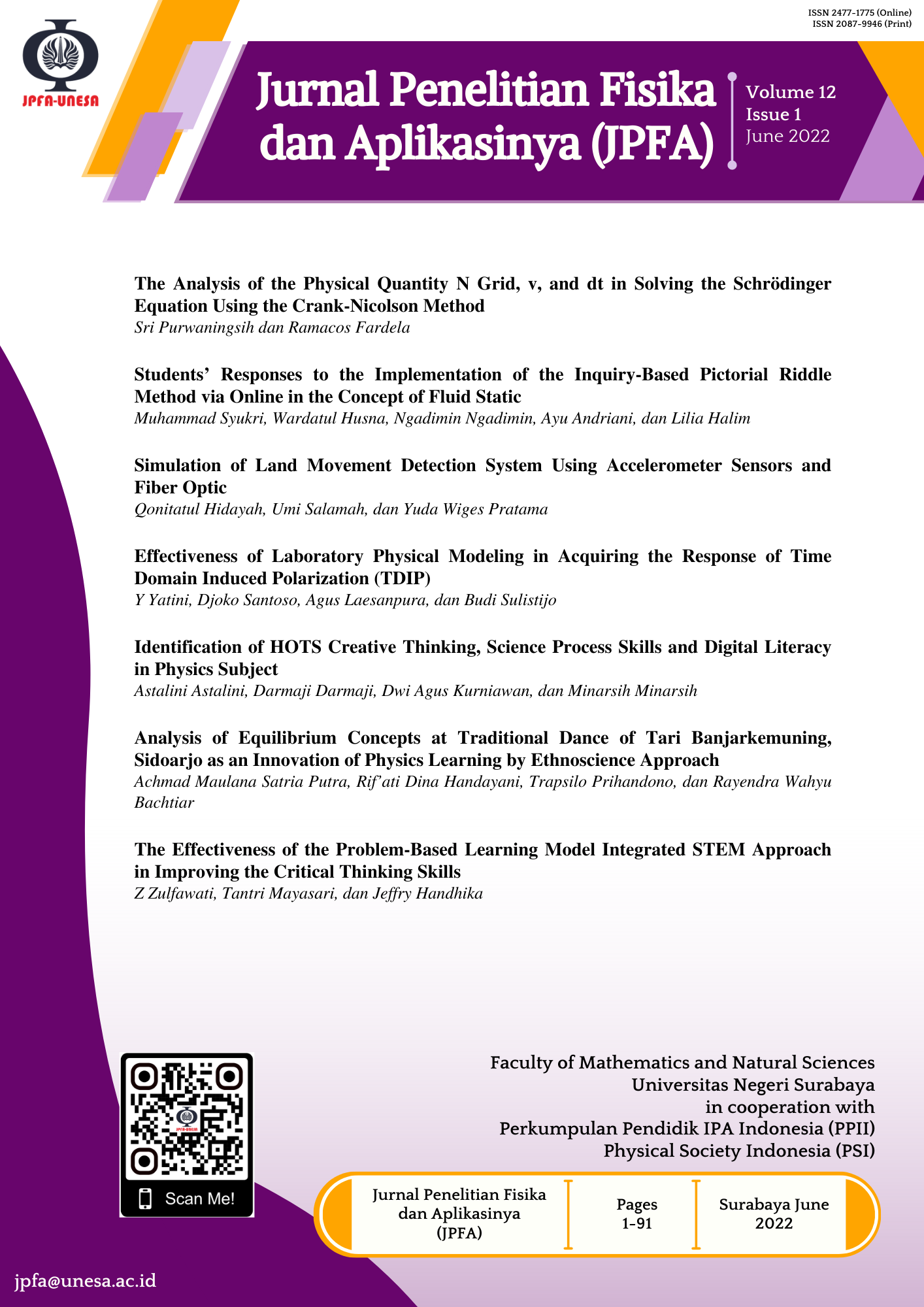The Analysis of the Physical Quantity N Grid, v, and dt in Solving the Schrödinger Equation Using the Crank-Nicolson Method
DOI:
https://doi.org/10.26740/jpfa.v12n1.p1-13Keywords:
Crack-Nicolson, wave functionAbstract
Solving the Schrödinger equation may result in a wave function of a particle in a quantum system, which can afford the information with respect to the particle’s behavior. The Schrödinger equation is useful for examining probability density and determining a wave function of free particles. This research focuses on solving the Schrödinger equation using the Crank-Nicolson method in free particles. The Crank-Nicolson method is a method of solving partial differential equations in the form of the Schrodinger equation, this method is very stable and accurate in giving numerical results. The result indicates that probability density and the form of the wave function of free particles are identified by varying the v, N grid, and dt. When dt = 1, v = 1, and v = 2, and the N grid remains at a score of 100, we acquire the same forms of the wave function and probability density. And yet, when dt = 2, v =2, and the N grid remains at a score of 100, the form of the wave function and probability density is constricted in one area. The N grid and dt are the two most affecting factors on the three variants. Using the Crank-Nicolson method, we can determine the wave function and probability for free particles by varying the value of N grid, dt.
References
Shangwha Y. Klein-Gordon Equation and wave Function Free Particle in Rindler Space-Time, International Journal of Advanced Reasearch in Physics Science, 2020; 7(9): 10-12. Available from: https://www.arcjournals.org/pdfs/ijarps/v7-i9/3.pdf.
Bondar DI, Lompay RR, and Liu WK. Quantum Mechanics of a Free Particle from properties of the Dirac delta function, American Journal Physics, 2011; 79: 392-394. DOI: https://doi.org/10.1119/1.3533715.
Berger MS and Maziashvilli M. Free Particle wavefunction in light of the minimal-length deformed quantum mechanics and some of its phenomenological implication, Physical Review D, 2011; 84: 044043. DOI: https://doi.org/10.1103/PhysRevD.84.044043.
Saxon DS. Elementary quantum mechanics. US: Courier Corporation; 2013.
Ajlouni AW, Joudeh B, and Salameh B. Particle in a box with dissipation, Journal Applied Science, 2007; 7(9): 1314-1320. DOI: https://doi.og/10.3923/jas.2007.1314.1320.
Olavo LSF. Foundations of quantum mechanics: non-relativistic theory. Physica A: Statistical Mechanics and its Applications. 1999; 262(1-2): 197-214. DOI: https://doi.org/10.1016/S0378-4371(98)00395-1.
Kumar PR and Dong SH. A new quantization rule to the bound state problem in non-relativistic quantum mechanics. Physics Letters A. 2021; 417: 127700. DOI: https://doi.org/10.1016/j.physleta.2021.127700.
Poveda LA, de Peralta LG, Pittman J, and Poirier B. Non-relativistic Approach to Relativistic Quantum Mechanics: The Case of the Harmonic Oscillator. Foundations of Physics. 2022; 52(1): 29. DOI: https://doi.org/10.1007/s10701-022-00541-5.
Laskin N. Fractals and quantum mechanics. Chaos: An Interdisciplinary Journal of Nonlinear Science. 2000; 10(4): 780-790. DOI: https://doi.org/10.1063/1.1050284.
Nagel JR. A review and application of the finite-difference time-domain algorithm applied to the Schrodinger equation. ACES Journal-Applied Computational Electromagnetics Society. 2009; 24(1): 1-8. Available from https://journals.riverpublishers.com/index.php/ACES/article/view/15873.
Sellier JM, Nedjalkov M, and Dimov I. An introduction to applied quantum mechanics in the Wigner Monte Carlo formalism. Physics Reports. 2015; 577: 1-34. DOI: https://doi.org/10.1016/j.physrep.2015.03.001.
Pauli W. General principles of quantum mechanics. New York: Springer Science & Business Media; 2012.
Blatt R and Roos CF. Quantum simulations with trapped ions. Nature Physics. 2012; 8(4): 277-284. DOI: https://doi.org/10.1038/nphys2252.
Weinberg S. The trouble with quantum mechanics. The New York Review of Books. 2017; 19: 1-7. Available: http://quantum.phys.unm.edu/466-19/QuantumMechanicsWeinberg.pdf.
Valentini A. Foundations of statistical mechanics and the status of the Born rule in de Broglie-Bohm pilot-wave theory. In Statistical mechanics and scientific explanation: determinism, indeterminism and laws of nature. 2020: pp. 423-477. DOI: https://doi.org/10.1142/9789811211720_0012.
Rosique F, Navarro PJ, Fernandez C, and Padilla A. A systematic review of perception system and simulators for autonomous vehicles research. Sensors. 2009; 19(3): 648. DOI: https://doi.org/10.3390/s19030648.
Vesely FJ, Davenport F, McKay S, and Christian W. Computational Physics: An Introduction. Computers in Physics. 1996; 10: 47. DOI: https://doi.org/10.1063/1.4822354.
Horbatsch M. Quantum Mechanics Using Maple. New York: Springe; 1995. Available from: https://link.springer.com/content/pdf/bfm:978-3-642-79538-1/1.pdf.
Amodio P, Brugnano L, and Iavernaro F. Analysis of Spectral Hamiltonian Boundary Value Methods (SHBVMs) for the numerical solution of ODE problems. Numerical Algorithms. 2020; 83(4): 1489-1508. DOI: https://doi.org/10.1007/s11075-019-00733-7.
Pang T. An introduction to computational physics. American Journal of Physics. 1999; 67(1): 94-95. DOI: https://doi.org/10.1119/1.19198.
Olga VM and Vladimir IM, Probability Representation of Quantum State. Entropy. 2021; 23(5): 549. DOI: https://doi.org/10.3390/e23050549.
Fadugba SE, Edogbanya OH, and Zelibe SC. Crank-Nicolson methods for solving Parabolic Partial Differential Equations. International Journal of Applied Mathematics and Modeling IJA2M. 2013; 1(3): 8-23.
Fernandes N and Bhadkamkar R. An overview of a Crank-Nicolson to solve parabolic differential partial equation. International Journal of Scientific and Engineering Research. 2016; 7(12): 1074-1078. Available from: https://www.ijser.org/onlineResearchPaperViewer.aspx?AN-OVERVIEW-OF-A-CRANK-NICOLSON-METHOD-TO-SOLVE-PARABOLIC-PARTIAL-DIFFERENTIAL-EQUATION.pdf.
Downloads
Published
How to Cite
Issue
Section
License
Copyright (c) 2022 Jurnal Penelitian Fisika dan Aplikasinya (JPFA)

This work is licensed under a Creative Commons Attribution-NonCommercial 4.0 International License.
Author(s) who wish to publish with this journal should agree to the following terms:
- Author(s) retain copyright and grant the journal right of first publication with the work simultaneously licensed under a Creative Commons Attribution-Non Commercial 4.0 License (CC BY-NC) that allows others to share the work with an acknowledgement of the work's authorship and initial publication in this journal for noncommercial purposes.
- Author(s) are able to enter into separate, additional contractual arrangements for the non-exclusive distribution of the journal's published version of the work (e.g., post it to an institutional repository or publish it in a book), with an acknowledgement of its initial publication in this journal.
The publisher publish and distribute the Article with the copyright notice to the JPFA with the article license CC-BY-NC 4.0.
 Abstract views: 812
,
Abstract views: 812
, PDF Downloads: 470
PDF Downloads: 470









